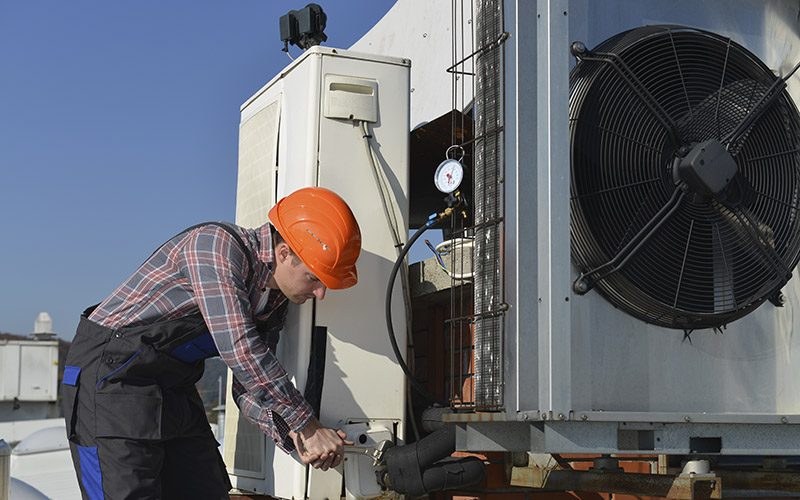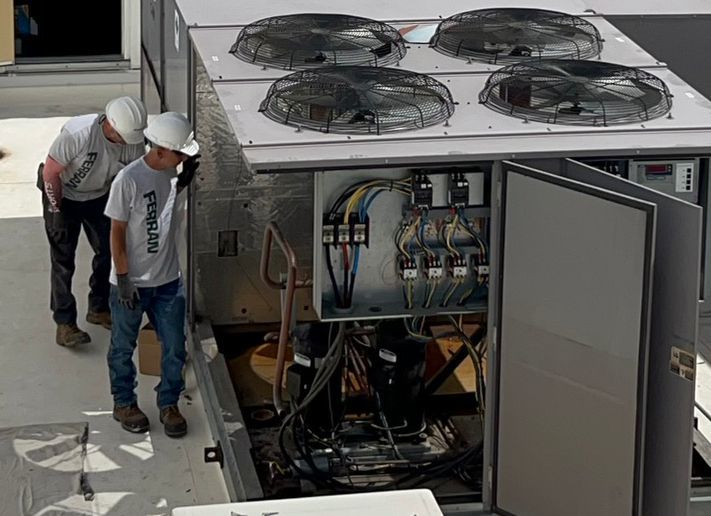Exactly How a Warmth Pump and Heater Job With Each Other to Enhance Your Home's Home heating Performance
Comprehending just how a heatpump and heating system job together is essential for home owners looking for efficient heating remedies. Each system has its toughness, providing a well balanced approach to home comfort. The warmth pump succeeds in modest temperature levels, while the heating system supplies quick heat throughout severe cold. This harmony not only lowers power expenses however additionally boosts the life expectancy of both devices. What variables influence this collaboration, and exactly how can property owners optimize their advantages?
Understanding Heat Pumps: Just How They Function
Several individuals might be strange with their internal operations, warm pumps play an important duty in contemporary home heating systems. These gadgets run by moving warmth from one area to one more, utilizing the principles of thermodynamics. In cooler months, a warmth pump extracts warm from the outside air, ground, or water, and transfers it inside to heat the space. Alternatively, during warmer months, it can reverse the procedure, acting as an air conditioning system by expelling warm from inside to the outside.Heat pumps include an evaporator, condenser, development, and compressor shutoff. The refrigerant within the system takes in warmth as it vaporizes at low temperature levels and pressures. The compressor then enhances the stress and temperature of the cooling agent, enabling it to release warm as it condenses. This efficient procedure can greatly minimize energy intake compared to traditional home heating methods, making warm pumps a sustainable choice for climate control in homes.
The Function of Heating Systems in Home Home Heating
Heating systems play a vital duty in home heating by giving a reliable resource of warmth during the chillier months. They operate by generating heat through burning or electrical resistance, distributing it throughout the home by means of ducts or radiant systems. The performance of a heater is commonly gauged by its Yearly Gas Usage Performance (AFUE) score, which indicates how successfully the system transforms gas right into heat.Furnaces can utilize different power sources, consisting of gas, lp, oil, or power, enabling home owners to pick the most suitable option for their demands. Unlike heatpump, which may struggle in extreme cold, heaters preserve constant performance, guaranteeing that interior temperature levels continue to be comfy despite outside problems. Additionally, contemporary furnaces often come equipped with advanced innovation, such as smart thermostats and variable-speed blowers, enhancing their efficiency and responsiveness. This convenience makes heaters an important part in all-encompassing home heating strategies.

Advantages of Using Both Systems Together
Combining the strengths of both heating systems and warm pumps can result in a more efficient and efficient home heating service. Utilizing both systems enables house owners to benefit from the heatpump's energy effectiveness throughout milder temperature levels while depending on the heating system for even more severe cold conditions. This double strategy can substantially lower energy expenses, as heatpump consume much less electricity than typical home heating methods when temperatures are moderate.Additionally, utilizing both systems with each other can enhance convenience degrees in the home. Heat pumps can give regular, even heating, while furnaces can swiftly increase ambient temperature levels when required. Moreover, the integration of both systems can extend the lifespan of devices by lowering deterioration on each unit, as they share the workload. Inevitably, property owners can delight in a well balanced, affordable heating solution that changes effortlessly to varying climate condition, making sure a cozy and welcoming home throughout the winter season.
Just How Warm Pumps and Furnaces Enhance Each Other
They produce a complementary home heating system that maximizes performance and convenience when homeowners integrate heat pumps and furnaces. Heat pumps run by transferring heat from the outdoors air or ground, making them highly efficient in modest environments. They succeed throughout milder temperature levels, giving affordable home heating. Alternatively, heaters generate heat through combustion or electrical resistance, delivering solid, prompt warmth during extreme chilly conditions.The mix of these two systems enables dynamic adjustments based upon temperature level variations. During warmer months or milder winter season days, the heatpump can take the lead, saving power and lowering prices. As temperatures decrease, the heating system can effortlessly engage, making certain consistent heat throughout the home. This harmony not just optimizes energy usage view website yet additionally enhances the life-span of both systems, as each system operates within its perfect performance range. With each other, they develop a well balanced environment that adapts to differing climate needs.
Optimizing Efficiency: Tips for Homeowners
Property owners can improve their home heating effectiveness via several functional approaches. Establishing a normal maintenance schedule, integrating clever thermostat innovation, and applying effective insulation and securing options are key actions. These actions not just boost convenience however likewise minimize energy costs.
Regular Upkeep Set Up
To ensure maximum heating performance, establishing a regular upkeep routine is crucial for any home. Home owners should prioritize regular inspections of both heatpump and heaters to ascertain peak performance. This includes changing air filters every one to three months, as clogged filters can greatly reduce performance. In addition, scheduling expert upkeep a minimum of yearly permits technicians to identify and resolve potential problems prior to they intensify. House owners ought to additionally clean up the warm pump's exterior device to prevent particles accumulation that can prevent airflow. By sticking to a routine maintenance timetable, house owners not just improve their heater' performance but also extend their lifespan, bring about higher convenience and decreased power costs throughout the colder months.
Smart Thermostat Integration
Integrating a clever thermostat into a home heating unit can considerably enhance power performance, especially as it enables specific control over temperature level settings. These tools can learn the homeowner's routine and preferences, immediately readjusting the temperature level to maximize convenience while decreasing energy usage. They can lower heating throughout times when the home is unoccupied, lowering unnecessary consumption. Several clever thermostats additionally give real-time power use information, making it possible for homeowners to make informed decisions concerning their home heating behaviors. In addition, remote gain access to using mobile phone applications allows individuals to adjust settings from anywhere, making certain the home is warm upon return. Overall, clever thermostat integration not just improves convenience yet significantly adds to power savings and performance.
Insulation and Sealing Solutions
Smart thermostats play a critical duty in power performance, but their effectiveness can be considerably boosted by proper insulation and sealing solutions. Home owners need to focus on protecting wall surfaces, floors, and attics to reduce warm loss. Premium insulation materials, such as spray foam or fiberglass, can considerably enhance thermal resistance. Additionally, sealing gaps around home windows, air ducts, and doors stops cold air infiltration and warmth getaway. Weatherstripping and caulking work approaches for addressing these leaks - heat pump installation ooltewah tn. Normal evaluations for air leakages, Discover More Here together with using blower door tests, can assist identify issue locations. By buying insulation and sealing, property owners can maximize the efficiency of their furnace, inevitably leading to lowered energy consumption and lower utility bills
Usual Misconceptions About Heat Pumps and Furnaces
What misconceptions border heatpump and heaters? Several people mistakenly think that warm pumps are inefficient in cooler climates. Actually, modern-day heat pumps are designed to operate effectively even in reduced temperature levels, giving dependable home heating throughout winter. An additional usual misconception is that furnaces are always a lot more reliable than heat pumps. Nonetheless, this relies on the particular power resources and efficiency scores of the devices in inquiry. Some may likewise believe that making use of both systems all at once is unnecessary, however as a matter of fact, this mix can optimize home heating performance, particularly throughout extreme climate condition. Furthermore, people commonly assume that heatpump require continuous maintenance, when in reality, they have comparable upkeep requires to traditional heater. By disproving these myths, home owners can make even more educated choices concerning their home heating alternatives, inevitably resulting in enhanced convenience and energy efficiency in their homes.
Upkeep Factors To Consider for Combined Solutions

Frequently Asked Concerns
Can Warm Pumps Work Effectively in Exceptionally Cold Climates?
Heat pumps can struggle in incredibly cold environments because of reduced effectiveness and heat extraction limitations. Advancements in innovation have led to models developed for much better performance in such problems, enhancing their viability in extreme atmospheres.
Just How Lengthy Do Warm Pumps and Furnaces Typically Last?
Heatpump normally last 15 to 20 years, while furnaces have a life-span of 15 to 30 years. Normal maintenance can extend their long life, making certain effective procedure and lowering the demand for early replacements.

What Is the Ordinary Price of Installing Both Equipments?
The average price of installing both a warmth pump and a heater normally ranges in between $5,000 to $10,000 - furnace replacement. Factors go to my blog affecting this expense consist of system size, installation complexity, and regional labor rates
Are There Tax Obligation Motivations for Using Energy-Efficient Heating Systems?
Lots of property owners ask about tax obligation incentives for energy-efficient heater. Different government and state programs usually supply credit ratings or refunds, motivating the fostering of lasting modern technologies to decrease energy consumption and advertise ecological obligation.
How Do I Choose the Right Dimension Heatpump and Heating System?
Selecting the right size heatpump and heating system involves calculating the home's square video, taking into consideration insulation high quality, and assessing regional climate. Consulting a professional can ensure excellent system efficiency and power effectiveness based upon certain needs. heat pump service. Comprehending exactly how a warmth pump and heater job together is important for homeowners seeking efficient home heating services. In cooler months, a warmth pump removes warmth from the outside air, ground, or water, and transfers it inside to warm up the living space. When house owners incorporate warm pumps and heaters, they create a corresponding heating system that optimizes effectiveness and convenience. Warmth pumps run by transferring warmth from the outdoors air or ground, making them extremely efficient in moderate climates. Heat pumps can battle in extremely cool climates due to decreased effectiveness and heat extraction restrictions